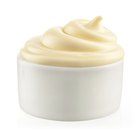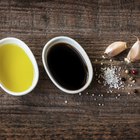
Mayonnaise is a relatively simple condiment to make at home. It requires just a few minutes of mixing as opposed to the hours of simmering required for ketchup. Getting the ingredients to mix properly is the part that intimidates many home cooks. If you get it wrong, your mayonnaise might be disappointingly thin or -- even worse -- not come together at all. Don't let that deter you from making your own. It's a simple process once you understand the principles and only needs a bit of patience.
Mayonnaise as Science
There's the proverb that oil and water don't mix, an axiom vividly illustrated by a bottle of vinaigrette. It forms a cloudy mixture when shaken, but quickly separates into distinct layers of oil and water-based vinegar. Mayonnaise takes those same ingredients and brings them together in a stable emulsion by incorporating egg yolks into the process. The eggs form chemical bonds with both the oil and the water-based eggs and vinegar, enabling fine droplets of oil to disperse throughout the eggs and vinegar. When it's done right, the mixture becomes very stiff and spreadable.
Master the Mixing
Mayonnaise recipes start with one or more egg yolks in your mixing bowl. One will emulsify a cup of oil though many recipes call for two. Whisk the yolks with a small pinch of salt, which helps them thicken, and then begin adding the oil a few drops at a time. Whisk until the oil is completely incorporated before adding a few drops more. Once the egg yolk has about doubled in volume, you can begin adding oil in a very thin, fine stream. It should blend into the mixture as quickly as you pour it, so slow down or stop for a moment if that isn't happening.
Through Thick and Thin
The consistency of your finished mayonnaise is affected by the ratio of water-based ingredients to oil. The more water it contains the thinner it becomes. Aside from the moisture of the egg yolks, most of the water comes in the form of lemon juice or vinegar. Some recipes call for it to be whisked into the eggs, but your mayonnaise will thicken better if you add it in the late stages. If you find that your mayonnaise has a smooth but thin, sauce-like consistency, add more oil -- a tablespoon at a time -- and keep whisking. It will thicken naturally as the additional oil disperses through the emulsion.
The Mayo Clinic
If your mayonnaise is thin and streaky with visible ribbons of oil and mayonnaise it has curdled or 'broken." That's dispiriting, but perfectly fixable. Keep a small cup of ice water next to your work area and at the first sign that your mayonnaise has broken add a few drops of cold water. This should bring the emulsion back together enabling you to continue. If it doesn't, you'll need a second mixing bowl. Whisk a fresh egg yolk and a pinch of salt in the new bowl and start pouring in the failed mayonnaise a few drops at a time. Work slowly and carefully until it's mixed in then add any remaining oil from the original recipe.
Related Articles

How to Fix Mayo With Broken Emulsion

Can You Mix Warm Noodles With Mayo?
Is Mayonnaise That Has Been Frozen Safe ...

How Is Emulsified Shortening Used in ...

Noxzema Ingredients

How to Keep Your Buttercream Icing With ...

How Can I Thicken My Italian Dressing?

How to Make Vanilla Ice Cream With ...
What Do Bakeries Use in Their Whipped ...

How to Fix Lumpy Buttercream Frosting

How to Fix Curdled Whipped Cream

Can I Use Mayo Instead of Eggs to Make ...
How to Bake Cupcakes With Mayo Instead ...

How to Lighten Up Burgundy Frosting

How to Use Shortening Instead of Oil ...

Cornstarch & Vinegar for Blackheads

How to Remove Hair With Ant Egg Oil

How to Mix Your Own Vinegar & Oil

Oils to Remove Moles

How to Mix Different Hair Dye Colors
References
- On Food and Cooking: The Science and Lore of the Kitchen; Harold McGee
- On Cooking: A Textbook of Culinary Fundamentals; Sarah Labensky, et al.
Writer Bio
Fred Decker is a trained chef and prolific freelance writer. In previous careers, he sold insurance and mutual funds, and was a longtime retailer. He was educated at Memorial University of Newfoundland and the Northern Alberta Institute of Technology. His articles have appeared on numerous home and garden sites including GoneOutdoors, TheNest and eHow.
Photo Credits
Jupiterimages/liquidlibrary/Getty Images